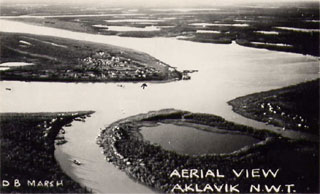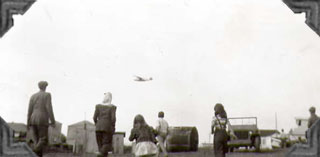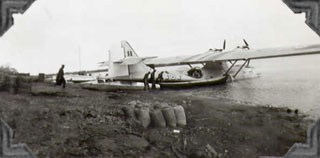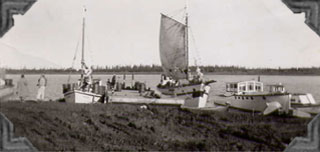Page
6: Aklavik

(Postcard)
I do not know the date when the photo was taken. Donald B. Marsh was
the Anglican Bishop of the Arctic in the fifties and started missionary
work in the Arctic in 1926. He was known as the "Flying Bishop"
and died in 1973. It seems likely that he was the photographer.
Getting
There
After handing over the station and our quarters
to our replacements in Fort Providence and saying farewells to friends
and neighbours, we boarded the regular Canadian Pacific Airlines plane,
a big DC-3, and flew down north. We arrived at Norman Wells, on the
Mackenzie River, some hours later, completing the first half of our
journey. The "Wells" are oil wells and they support a thriving
community. Airline passengers waiting to change planes stayed overnight
there in a hotel, at a cost of $20 a night; the accommodations seemed
unusually sophisticated for the North, as hotels were few and far
between. It
was a welcome break in our journey and we enjoyed our short, restful
stay.

Plane
arriving at Aklavik (1956)
On the following
morning the passengers for Aklavik climbed into a smaller, Norseman
plane and continued on our way. After a long day's flight, the small
floatplane landed at last, late at night, upon the Mackenzie River
in Aklavik. This being July and truly the land of the midnight sun,
it was still as bright as day.

Unloading
supplies from plane (1956)
We stepped out
of the plane into a cloud of mosquitoes to face what seemed to be
the entire population of Aklavik, lined up along the riverbank. Meeting
and welcoming the regular plane and satisfying one's curiosity about
who had arrived was a regular source of entertainment for all northern
inhabitants. As I was about seven months pregnant at the time of our
arrival, and had spent most of the journey being miserably airsick,
I did not exactly feel ready, physically or mentally, for this unexpected
mass reception. However, we did appreciate the goodwill demonstrated
in our welcome, even if we were not quite in the best shape to show
it.
Aklavik
At the time of
our arrival in 1952, Aklavik was the centre of government for the
western Arctic; the chief administrator was Assistant Commissioner
L.A.C.O. Hunt. In 1958 the government centre was moved across the
delta to the new town of Inuvik, and Aklavik now has a much smaller
population than when we lived there.
Aklavik ("place
of the Barren Lands grizzly bear") is built on one of the many
branches of the Mackenzie delta as the river divides on its way to
its final destination in the Arctic Ocean. The small town is one hundred
and thirty miles north of the Arctic Circle and thirty miles south
of the Arctic Ocean. It population in 1951 was composed of about a
thousand "Eskimos" (now known as Inuvialuit), about two
hundred Loucheux Indians (now known as Gwich'in), and a hundred and
fifty whites.
The daily lives
of the Native inhabitants are illustrated by some short articles by
the children of All Saints' School, in two issues of the school's
newsletter, The Muskrat. In the June 1951 issue:
William
Kunnizzi ("Indian Age 15") writes in "Fishing":
We go fishing in the month of July. We set nets and we catch fish;
not many but we get some anyway. The names of some of the fish I
know around here are: herring, connie, grayling, jackfish, whitefish
and crooked backs. There were not many fish this last summer. The
water was very low. The biggest run of fish comes in late August,
and lasts for two or three weeks, so that is the only chance we
have of catching many. My father made a fish wheel to catch fish.
The biggest catch was thirteen hundred herring as well as other
fish, during the season. Sometimes we have six or seven nets set
and catch six or seven hundred fish a day. We cut the fish and dry
it. What we cannot handle we save for dog food.

Inuit
Boats from Banks Island at Aklavik (1956)
William
Allen ("Eskimo age 12") writes in "Whaling":
This is my story of whaling in the Arctic Ocean. My father and the
other men go out in their boats to get whale. We see whales jumping
in the air and diving in the water. The little ones are gray and
they jump the most. The mothers just come up to have air and to
breathe. Once we went whaling. My father was shooting the whale.
It was shot in the head twice. It started to go mad. It went under
the boat and started to hit the front of the boat. My father shot
it in the back. It sank to the bottom. The water was shallow. We
looked for an hour. Finally we found it and my father threw the
harpoon into it. We stopped for a meal. On our way back home my
father let me take the wheel. After my father took the wheel and
I went to sleep. When I woke up we were at the shore and the whale
was pulled up. When the women finished their dinner they started
to cut the whale into big pieces. The whale is used for food. Oil
is taken from the blubber and put into barrels. The meat is stripped
off and hung up to dry. The whale has a tiny ear. The skin is also
used for shoes.
Sammy
Smith ("Indian age 14") writes in "Reindeer Roundup":
The roundup begins about July the 25th. The herders bring the herd
near the corrals and when all is ready they are driven into the
first corral. Then the herders go and get their meals.
Before the checking begins the herders decide who will go into the
first pen and who will go into the second pen. The herders start
putting the deer through the pens and count them. There are different
classes of reindeer such as yearling bulls, adult bulls, adult females,
yearling steers or one year female fawns. The deer are frightened
animals so you must not make much noise or throw stones at them.
There is much fun in catching the fawns. When the man who is counting
the deer tells us to catch them we try to do so. They kick and wrestle
to try to free themselves. The fawns have to have their ears cut
with a mark something like a V. Sometimes the big deer have to be
castrated. When the work on a reindeer is finished it is let out
into the end corral where the other finished deer are to be let
go when the corral gate is opened.
Some of the big deer have to be vaccinated. I can remember one time
I had to bring one fawn to one of the separate pens where they do
the first aid work. This one that I brought was a strong one. It
kicked and kicked. I was kicked in the knee but it did not hurt.
Some of the fawns have to be tagged. The tag is a strip of copper
with some writing on it. It is tagged on the ear.
John
Alex Robert ("Indian age 12") writes in "Trapping
Time":
A long time ago, before I came to school, I used to set traps with
my brother. He set traps on the bank of the creek. Once he told
me to go with him to his traps. A lynx was caught in a trap. It
dragged it through the creek a little way. It was caught by one
of its hind legs and was alive. We had no gun so my brother went
back to the sled to get some wire. I was scared and followed him
everywhere he went. After he had the wire he cut a willow. He put
the wire on the end of the willow and made it round like a rabbit
snare. Then he went to the lynx and he held the wire near its head.
It jumped and its head went in the loop and the wire was around
its neck. He went to the bush. The lynx could not go after him because
the chain which held the trap was tied to a big willow. He pulled
the wire and the lynx couldn't breathe so it choked.
The school had
its own trapping area too, and this last article, "Trapping,"
describes a school expedition:
Jeannie
Ekaksak ("Eskimo age 14"):
The
ratting season opens March first. We do not start until the beginning
of April when it is warmer. We went across the river to our ratting
area. It is nice to walk alone in the soft snow. We went to one
lake and looked for rat push-ups. They were frozen so we went to
another lake which was no better. On the way to the third lake through
the willows we saw ptarmigan tracks. They have three toe nails.
When we reached the lake Joanne and Jessie were setting traps. I
found a rat house. I took some snow off and opened the house. I
put in my hand and felt something inside. I screamed and ran. I
thought it was a live rat. The others laughed at me. Emma chopped
the snow away and we saw a dead rat. You have to be careful with
a live muskrat for they bite. We kill them with a stick. We set
a trap on the muskrat's bed. When they come up through the hole
in the ice to eat they get caught in the trap. When the trap is
set we repair the opening made in the house and cover it well. The
hole might freeze and we could not use it again. While we were setting
the trap bubbles came up and a muskrat put his head right out of
the house. After supper the children who have caught rats skin and
stretch them. We give the meat to Mrs. Cooper to cook for our dinner.
The last article
is illustrated by a drawing entitled "Girls Skinning Rats in
the Furnace Room" that shows a large heap of dead muskrats and
two girls each skinning a rat hung from a shelf above. The front cover
of the seven-page school paper was designed by Woodie Elias of Fort
McPherson; under the title is a picture of a muskrat chewing on a
willow branch.
[Next
Page]
Pages: [1]
[2] [3]
[4] [5]
[6] [7] [8]
[9] [10]
[11] [12]
[13] [14]
[15] [16]
Return to top of
page
Return to the Watts
Family page